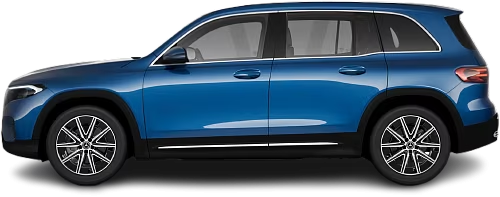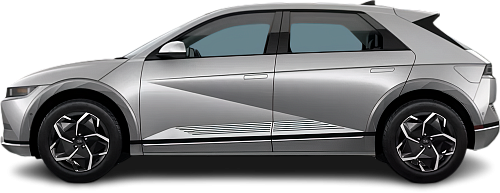Global EV Comparison: Mercedes EQB 300 4MATIC vs Hyundai Ioniq 5 Standard Range AWD
Struggling to Decide? Let AI Help!
Your AI Summary Is Ready!
General Info
The Mercedes EQB 300 4MATIC (2023-…) is currently produced, it has a starting price of €55519. The Hyundai Ioniq 5 Standard Range AWD (2021-2022) has been discontinued. You can find it for as low as €33900 on the used car market.
The two vehicles share the same body style: SUV.
| Property | Mercedes EQB 300 4MATIC | Hyundai Ioniq 5 Standard Range AWD |
|---|---|---|
| Years of Production | 2023-… | 2021-2022 |
| Current Status | Produced | Discontinued |
| Country of Manufacture | Hungary | Indonesia, Singapore, South Korea |
| Body Style | SUV | SUV |
| Market Availability | EU, USA | EU |
| Price Europe (New) | €55519 | - Price Europe (New) |
| Price Europe (Used) | €34900 | €33900 |
| GCC Score | 6 | 6.4 |
Range and Efficiency
While the Mercedes EQB 300 4MATIC (2023-…) offers a longer real-world range and a bigger battery, it is less energy-efficient than the Hyundai Ioniq 5 Standard Range AWD (2021-2022).
| Property | Mercedes EQB 300 4MATIC | Hyundai Ioniq 5 Standard Range AWD |
|---|---|---|
| Range (EPA) | 330 km | - Range (EPA) |
| Range (WLTP) | 448 km | 362 km |
| Range (GCC) | 350 km | 308 km |
| Battery Capacity (Nominal) | 69.7 kWh | 58 kWh |
| Battery Capacity (Usable) | 66.5 kWh | 54 kWh |
| Efficiency per 100 km | 19 kWh/100 km | 17.5 kWh/100 km |
| Efficiency per kWh | 5.26 km/kWh | 5.7 km/kWh |
| Range and Efficiency Score | 5.8 | 5.8 |
Charging
The Hyundai Ioniq 5 Standard Range AWD (2021-2022) features an advanced 800-volt architecture, whereas the Mercedes EQB 300 4MATIC (2023-…) relies on a standard 400-volt system.
The Hyundai Ioniq 5 Standard Range AWD (2021-2022) offers faster charging speeds at DC stations, reaching up to 175 kW, while the Mercedes EQB 300 4MATIC (2023-…) maxes out at 100 kW.
Both vehicles are equipped with the same on-board charger, supporting a maximum AC charging power of 11 kW.
| Property | Mercedes EQB 300 4MATIC | Hyundai Ioniq 5 Standard Range AWD |
|---|---|---|
| Max Charging Power (AC) | 11 kW | 11 kW |
| Max Charging Power (DC) | 100 kW | 175 kW |
| Architecture | 400 V | 800 V |
| Charge Port | CCS Type 2 | CCS Type 2 |
| Charging Score | 5.4 | 6.9 |
Performance
Both vehicles are all-wheel drive.
The Hyundai Ioniq 5 Standard Range AWD (2021-2022) boasts greater motor power and accelerates faster from 0 to 100 km/h.
| Property | Mercedes EQB 300 4MATIC | Hyundai Ioniq 5 Standard Range AWD |
|---|---|---|
| Drive Type | AWD | AWD |
| Motor Type | IM (front), PMSM (rear) | PMSM (front), PMSM (rear) |
| Motor Power (kW) | 168 kW | 173 kW |
| Motor Power (hp) | 225 hp | 232 hp |
| Motor Torque | 390 Nm | 605 Nm |
| 0-100 km/h | 8 s | 6.1 s |
| Top Speed | 160 km/h | 185 km/h |
| Performance Score | 3.7 | 4.8 |
Dimensions
The Hyundai Ioniq 5 Standard Range AWD (2021-2022) has a wider body, offering a more shoulder room, while the Mercedes EQB 300 4MATIC (2023-…) stands taller for a more elevated driving position. Despite these differences, their lengths are nearly identical.
The Hyundai Ioniq 5 Standard Range AWD (2021-2022) boasts a more extended wheelbase.
| Property | Mercedes EQB 300 4MATIC | Hyundai Ioniq 5 Standard Range AWD |
|---|---|---|
| Length | 4684 mm | 4635 mm |
| Width (with Mirrors) | 2020 mm | 2152 mm |
| Width (w/o Mirrors) | 1834 mm | 1890 mm |
| Height | 1667 mm | 1605 mm |
| Wheelbase | 2829 mm | 3000 mm |
Cargo and Towing
The Hyundai Ioniq 5 Standard Range AWD (2021-2022) features a larger trunk, but the Mercedes EQB 300 4MATIC (2023-…) offers greater maximum cargo capacity when the rear seats are folded.
A frunk (front trunk) is available in the Hyundai Ioniq 5 Standard Range AWD (2021-2022), but the Mercedes EQB 300 4MATIC (2023-…) doesn’t have one.
The Mercedes EQB 300 4MATIC (2023-…) has a towing capacity of up to 1700 kg, whereas the Hyundai Ioniq 5 Standard Range AWD (2021-2022) is not officially rated for towing in the EU.
| Property | Mercedes EQB 300 4MATIC | Hyundai Ioniq 5 Standard Range AWD |
|---|---|---|
| Number of Seats | 5, 7 | 5 |
| Curb Weight | 2165 kg | 2015 kg |
| Cargo Volume (Trunk) | 495 l | 531 l |
| Cargo Volume (Max) | 1710 l | 1591 l |
| Cargo Volume (Frunk) | - Cargo Volume (Frunk) | 24 l |
| Towing Capacity | 1700 kg | - Towing Capacity |
| Cargo and Towing Score | 7.4 | 6.6 |




